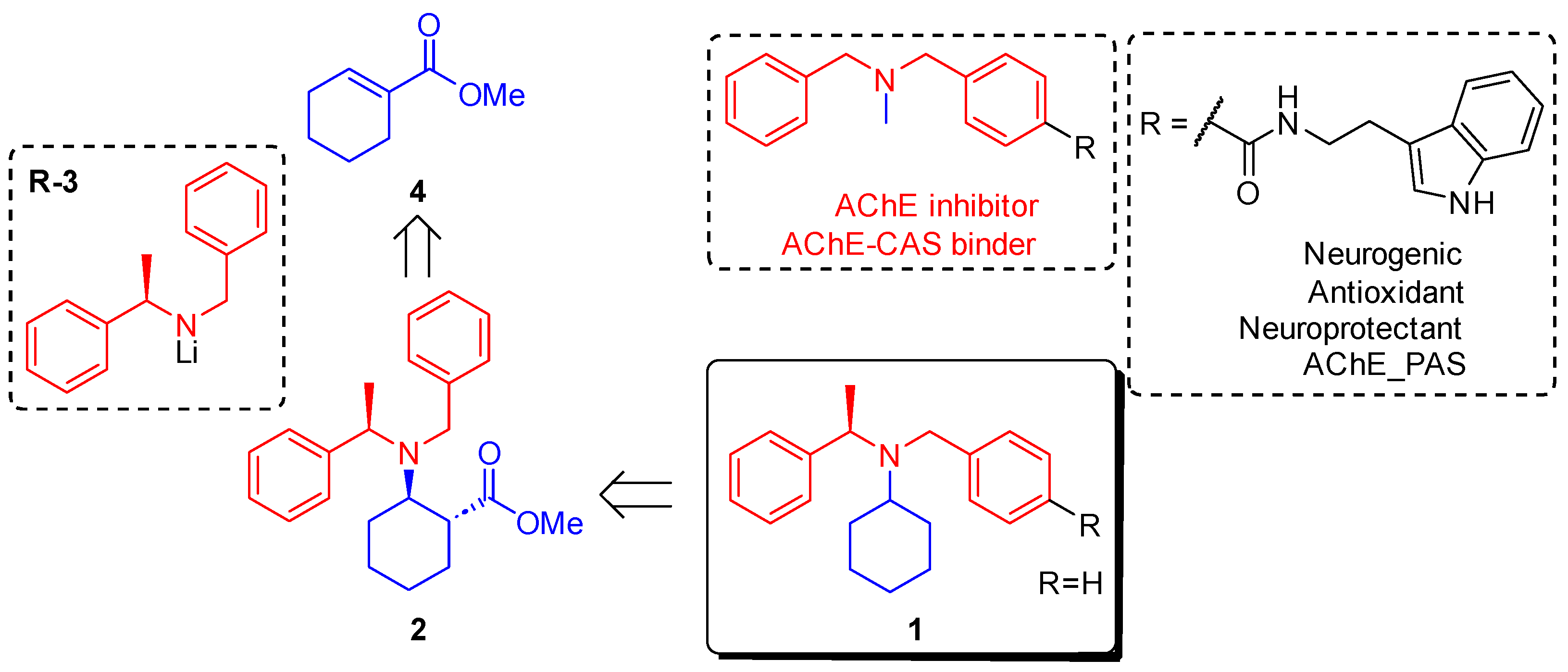(R)-N-Benzyl-N-(1-phenylethyl)cyclohexanamine
Abstract
1. Introduction
2. Results and Discussion
3. Materials and Methods
4. Conclusions
Supplementary Materials
Author Contributions
Funding
Data Availability Statement
Acknowledgments
Conflicts of Interest
Sample Availability
References
- de Freitas Silva, M.; Dias, K.S.T.; Gontijo, V.S.; Ortiz, C.J.C.; Viegas, C., Jr. Multi-Target Directed Drugs as a Modern Approach for Drug Design Towards Alzheimer’s Disease: An Update. Curr. Med. Chem. 2018, 25, 3491–3525. [Google Scholar] [CrossRef] [PubMed]
- Buendia, I.; Egea, J.; Parada, E.; Navarro, E.; León, R.; Rodríguez-Franco, M.I.; López, M.G. The Melatonin- N,N-Dibenzyl(N-Methyl)Amine Hybrid ITH91/IQM157 Affords Neuroprotection in an in Vitro Alzheimer’s Model via Hemo-Oxygenase-1 Induction. ACS Chem. Neurosci. 2015, 6, 288–296. [Google Scholar] [CrossRef] [PubMed]
- Estrada, M.; Herrera-Arozamena, C.; Pérez, C.; Viña, D.; Romero, A.; Morales-García, J.A.; Pérez-Castillo, A.; Rodríguez-Franco, M.I. New Cinnamic—N-Benzylpiperidine and Cinnamic—N,N-Dibenzyl(N-Methyl)Amine Hybrids as Alzheimer-Directed Multitarget Drugs with Antioxidant, Cholinergic, Neuroprotective and Neurogenic Properties. Eur. J. Med. Chem. 2016, 121, 376–386. [Google Scholar] [CrossRef] [PubMed]
- López-Iglesias, B.; Pérez, C.; Morales-García, J.A.; Alonso-Gil, S.; Pérez-Castillo, A.; Romero, A.; López, M.G.; Villarroya, M.; Conde, S.; Rodríguez-Franco, M.I. New Melatonin- N, N -Dibenzyl(N -Methyl)Amine Hybrids: Potent Neurogenic Agents with Antioxidant, Cholinergic, and Neuroprotective Properties as Innovative Drugs for Alzheimers Disease. J. Med. Chem. 2014, 57, 3773–3785. [Google Scholar] [CrossRef] [PubMed]
- Silva Gontijo, V.; Dias Viegas, F.P.; Juliet Cristancho Ortiz, C.; de Freitas Silva, M.; Miranda Damasio, C.; Chagas Rosa, M.; Gaspar Campos, T.; Souza Couto, D.; Simone Tranches Dias, K.; Viegas, C., Jr. Molecular Hybridization as a Tool in the Design of Multi-Target Directed Drug Candidates for Neurodegenerative Diseases. Curr. Neuropharmacol. 2020, 18, 348–407. [Google Scholar] [CrossRef] [PubMed]
- Mesiti, F.; Chavarria, D.; Gaspar, A.; Alcaro, S.; Borges, F. The Chemistry Toolbox of Multitarget-Directed Ligands for Alzheimer’s Disease. Eur. J. Med. Chem. 2019, 181, 111572. [Google Scholar] [CrossRef] [PubMed]
- Sang, Z.; Wang, K.; Dong, J.; Tang, L. Alzheimer’s Disease: Updated Multi-Targets Therapeutics Are in Clinical and in Progress. Eur. J. Med. Chem. 2022, 238, 114464. [Google Scholar] [CrossRef]
- Estrada-Valencia, M.; Herrera-Arozamena, C.; Pérez, C.; Viña, D.; Morales-García, J.A.; Pérez-Castillo, A.; Ramos, E.; Romero, A.; Laurini, E.; Pricl, S.; et al. New Flavonoid–N,N-Dibenzyl(N-Methyl)Amine Hybrids: Multi-Target-Directed Agents for Alzheimer´s Disease Endowed with Neurogenic Properties. J. Enzyme. Inhib. Med. Chem. 2019, 34, 712–727. [Google Scholar] [CrossRef] [PubMed]
- Manchado, A.; García, M.; Salgado, M.M.; Díez, D.; Garrido, N.M. A Novel Barton Decarboxylation Produces a 1,4-Phenyl Radical Rearrangement Domino Reaction. Tetrahedron 2018, 74, 5240–5247. [Google Scholar] [CrossRef]
- Barton, D.H.R. The Use of Photochemical Reactions in Organic Synthesis. Pure Appl. Chem. 1968, 16, 1–16. [Google Scholar] [CrossRef]
- Barton, D.H.R.; Crich, D.; Motherwell, W.B. The Invention of New Radical Chain Reactions. Part VIII. Radical Chemistry of Thiohydroxamic Esters; A New Method for the Generation of Carbon Radicals from Carboxylic Acids. Tetrahedron 1985, 41, 3901–3924. [Google Scholar] [CrossRef]
- Barton, D.H.R.; Bridon, D.; Fernandaz-Picot, I.; Zard, S.Z. The Invention of Radical Reactions: Part XV. Some Mechanistic Aspects of the Decarboxylative Rearrangement of Thiohydroxamic Esters. Tetrahedron 1987, 43, 2733–2740. [Google Scholar] [CrossRef]
- Davies, S.G.; Smith, A.D.; Price, P.D. The Conjugate Addition of Enantiomerically Pure Lithium Amides as Homochiral Ammonia Equivalents: Scope, Limitations and Synthetic Applications. Tetrahedron Asymmetry 2005, 16, 2833–2891. [Google Scholar] [CrossRef]
- Davies, S.G.; Fletcher, A.M.; Roberts, P.M.; Thomson, J.E. The Conjugate Addition of Enantiomerically Pure Lithium Amides as Chiral Ammonia Equivalents Part II: 2005–2011. Tetrahedron Asymmetry 2012, 23, 1111–1153. [Google Scholar] [CrossRef]
- Davies, S.G.; Fletcher, A.M.; Roberts, P.M.; Thomson, J.E. The Conjugate Addition of Enantiomerically Pure Lithium Amides as Chiral Ammonia Equivalents Part III: 2012–2017. Tetrahedron Asymmetry 2017, 28, 1842–1868. [Google Scholar] [CrossRef]
- Salgado, M.M.; Manchado, A.; Nieto, C.T.; Díez, D.; Garrido, N.M. Asymmetric Synthesis of 2,3,6-Trisubstituted Piperidines via Baylis–Hillman Adducts and Lithium Amide through Domino Reaction. Synlett 2019, 31, 600–604. [Google Scholar] [CrossRef]
- Manchado, A.; Ramos, V.E.; Díez, D.; Garrido, N.M. Multicomponent Domino Reaction in the Asymmetric Synthesis of Cyclopentan[c]Pyran Core of Iridoid Natural Products. Molecules 2020, 25, 1308. [Google Scholar] [CrossRef]


Disclaimer/Publisher’s Note: The statements, opinions and data contained in all publications are solely those of the individual author(s) and contributor(s) and not of MDPI and/or the editor(s). MDPI and/or the editor(s) disclaim responsibility for any injury to people or property resulting from any ideas, methods, instructions or products referred to in the content. |
© 2023 by the authors. Licensee MDPI, Basel, Switzerland. This article is an open access article distributed under the terms and conditions of the Creative Commons Attribution (CC BY) license (https://creativecommons.org/licenses/by/4.0/).
Share and Cite
García-González, Á.; Belda, L.; Manchado, A.; Nieto, C.T.; Garrido, N.M. (R)-N-Benzyl-N-(1-phenylethyl)cyclohexanamine. Molbank 2023, 2023, M1561. https://doi.org/10.3390/M1561
García-González Á, Belda L, Manchado A, Nieto CT, Garrido NM. (R)-N-Benzyl-N-(1-phenylethyl)cyclohexanamine. Molbank. 2023; 2023(1):M1561. https://doi.org/10.3390/M1561
Chicago/Turabian StyleGarcía-González, Ángel, Leland Belda, Alejandro Manchado, Carlos T. Nieto, and Narciso Martín Garrido. 2023. "(R)-N-Benzyl-N-(1-phenylethyl)cyclohexanamine" Molbank 2023, no. 1: M1561. https://doi.org/10.3390/M1561
APA StyleGarcía-González, Á., Belda, L., Manchado, A., Nieto, C. T., & Garrido, N. M. (2023). (R)-N-Benzyl-N-(1-phenylethyl)cyclohexanamine. Molbank, 2023(1), M1561. https://doi.org/10.3390/M1561





